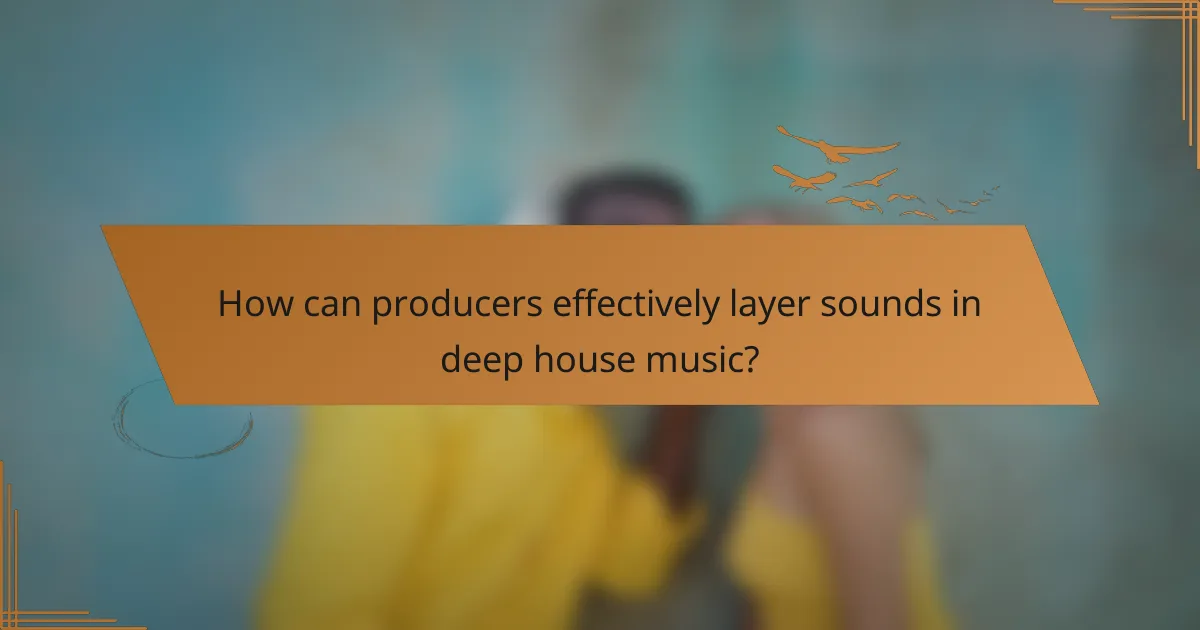Deep house music production techniques focus on layering sounds and creating atmospheric elements to achieve a rich listening experience. Key techniques include using soft synthesizers for melodic layers, deep basslines for rhythm, and sidechain compression for clarity. Producers enhance spatial depth with reverb and delay effects while incorporating vocal samples to add texture and emotion. Additionally, automation is utilized to craft dynamic transitions, ensuring an engaging arrangement. Experimentation with sound sources, complementary frequencies, and modulation effects further enriches the overall deep house soundscape.

What are Deep House Music Production Techniques?
Deep house music production techniques involve layering sounds and creating atmospheric elements. Key techniques include using soft synths for melodic layers. This creates a warm, immersive sound. Additionally, deep basslines are essential for driving the rhythm. Sidechain compression is often applied to ensure clarity and punch. Reverb and delay effects enhance spatial depth. Vocal samples are frequently used to add texture and emotion. Lastly, automation helps in crafting dynamic transitions throughout the track. Each technique contributes to the overall deep house sound, ensuring a rich listening experience.
How do these techniques enhance sound layering?
These techniques enhance sound layering by allowing multiple audio elements to coexist harmoniously. They involve using EQ to carve out space for each sound. This prevents frequency clashes and maintains clarity. Additionally, effects like reverb and delay create depth and dimension. This adds richness to the overall mix. Layering techniques also include panning sounds across the stereo field. This creates a sense of width and immersion. Furthermore, dynamic processing can help control levels between layers. This ensures that no single element overwhelms the others. Collectively, these methods contribute to a cohesive and engaging soundscape.
What are the fundamental principles of sound layering in deep house music?
The fundamental principles of sound layering in deep house music include texture, frequency balance, and dynamic range. Texture involves combining various sounds to create a rich auditory experience. This can include pads, basslines, and percussion elements. Frequency balance ensures that each sound occupies its own space in the mix. This prevents muddiness and allows individual elements to shine. Dynamic range refers to the difference between the quietest and loudest parts of a track. Maintaining a balanced dynamic range helps to keep the listener engaged.
Additionally, using complementary sounds enhances the overall atmosphere. Layering sounds that blend well can create a cohesive sonic environment. It’s important to consider the emotional impact of each layer. Each sound should contribute to the mood of the track. Effective sound layering also involves careful panning. Panning elements across the stereo field creates a sense of width. This adds depth to the overall mix.
In summary, successful sound layering in deep house music relies on texture, frequency balance, dynamic range, complementary sounds, emotional impact, and panning. These principles work together to create a polished and immersive listening experience.
How does sound layering contribute to the overall atmosphere of a track?
Sound layering enhances the overall atmosphere of a track by creating depth and richness. This technique involves combining multiple sound elements to build a fuller sonic experience. Layering can include harmonies, textures, and rhythmic components. Each layer adds complexity and can evoke specific emotions. For instance, ambient pads can create a sense of space, while bass layers provide warmth and foundation. Research indicates that well-executed sound layering can significantly impact listener engagement and emotional response. A study by the Journal of Music Theory found that tracks with effective layering techniques are perceived as more immersive.
What role does atmosphere play in deep house music production?
Atmosphere is crucial in deep house music production. It enhances emotional depth and creates immersive listening experiences. Producers use various soundscapes to evoke feelings. Ambient pads and lush synths contribute to this atmospheric quality. Reverb and delay effects further enrich the sound. These techniques help establish a mood that resonates with listeners. The use of field recordings can also add a unique texture. Overall, atmosphere shapes the identity of deep house tracks.
Why is atmosphere crucial in creating engaging deep house tracks?
Atmosphere is crucial in creating engaging deep house tracks because it establishes the emotional context for the listener. Deep house music relies heavily on immersive soundscapes that evoke feelings of relaxation and introspection. The use of ambient sounds, pads, and reverb contributes to a rich auditory experience. This layered sound design creates depth and complexity, enhancing the overall mood. Tracks with a well-defined atmosphere tend to resonate more with audiences, encouraging emotional connection. Research indicates that immersive audio environments can increase listener engagement by up to 40%. This highlights the importance of atmosphere in deep house production.
What elements contribute to the atmospheric quality of deep house music?
The atmospheric quality of deep house music is contributed by elements such as lush synth pads, deep basslines, and intricate percussion. Lush synth pads create a warm and immersive soundscape. Deep basslines provide a foundation that enhances emotional depth. Intricate percussion adds rhythm while maintaining a smooth flow. Additionally, ambient soundscapes and field recordings can enrich the texture. Reverb and delay effects enhance spatial qualities, making the music feel expansive. Vocal samples, often processed, can evoke feelings and memories, adding to the atmosphere. Together, these elements create a cohesive and immersive listening experience characteristic of deep house music.

How can producers effectively layer sounds in deep house music?
Producers can effectively layer sounds in deep house music by utilizing complementary frequencies and textures. This involves selecting sounds that harmonize well together. For instance, a deep bass can be paired with soft pads to create a rich atmosphere. Additionally, using EQ to carve out space for each sound is crucial. This ensures that no two elements compete for the same frequency range.
Producers should also experiment with different sound sources. Combining organic sounds with electronic elements can add depth. Furthermore, applying reverb and delay can enhance the spatial quality of the layers. This technique allows sounds to blend seamlessly while maintaining clarity.
Finally, automation can be used to create movement within the layers. This keeps the arrangement dynamic and engaging throughout the track. By following these methods, producers can achieve a well-layered and immersive deep house sound.
What tools and software are essential for sound layering?
Essential tools and software for sound layering include Digital Audio Workstations (DAWs), synthesizers, and audio effects plugins. Popular DAWs like Ableton Live, FL Studio, and Logic Pro provide comprehensive environments for sound layering. Synthesizers such as Serum and Massive allow for creating rich, textured sounds. Audio effects plugins, including reverb, delay, and EQ, enhance the layering process. These tools enable producers to manipulate sound elements effectively. The integration of these tools facilitates a more dynamic and immersive sound experience in deep house music production.
Which digital audio workstations (DAWs) are best suited for deep house production?
Ableton Live, FL Studio, and Logic Pro X are the best digital audio workstations (DAWs) for deep house production. Ableton Live is favored for its intuitive session view and powerful MIDI capabilities. FL Studio offers a user-friendly interface and extensive plugin support. Logic Pro X provides high-quality virtual instruments and advanced audio editing features. These DAWs support the layering of sounds essential for deep house music. They also allow for the creation of atmospheric textures, which is crucial in this genre. Many producers in the deep house scene utilize these DAWs for their versatility and robust features.
What plugins can enhance sound layering in deep house tracks?
Plugins that can enhance sound layering in deep house tracks include Serum, Massive, and Omnisphere. Serum is a wavetable synthesizer known for its rich sound design capabilities. Massive offers deep bass and wide pads, essential for creating atmospheric layers. Omnisphere is renowned for its vast library of sounds, perfect for adding depth. Additionally, Valhalla Room provides high-quality reverb, enhancing spatial effects in layered sounds. FabFilter Pro-Q is excellent for precise EQ adjustments, allowing for clearer layering. These plugins are widely used in the industry, proving their effectiveness in deep house music production.
How can sound selection impact layering techniques?
Sound selection significantly impacts layering techniques in music production. Choosing the right sounds affects the overall texture and depth of a track. For instance, complementary sounds enhance the richness of layered elements. Conversely, clashing sounds can create muddiness and reduce clarity. Specific frequencies from selected sounds can either reinforce or cancel each other out. The use of contrasting timbres can create a more dynamic and engaging soundscape. Additionally, the spatial characteristics of sounds influence how they blend in a mix. Proper sound selection ensures that each layer serves a distinct purpose, contributing to the overall atmosphere.
What types of sounds are commonly used in deep house music?
Deep house music commonly uses smooth basslines, soulful vocals, and atmospheric pads. Basslines provide a deep, resonant foundation, often characterized by sub-bass frequencies. Vocals in deep house are typically melodic and emotive, contributing to the genre’s soulful vibe. Atmospheric pads create a lush soundscape, enhancing the overall depth and texture. Percussion elements include soft hi-hats and shuffling snares, adding rhythmic complexity. Synth stabs and keys are also prevalent, offering melodic hooks. These sound elements work together to establish the genre’s signature groove and immersive atmosphere.
How do different sound textures affect the layering process?
Different sound textures significantly influence the layering process in music production. Textures can range from smooth and airy to rough and gritty. Each texture contributes uniquely to the overall soundscape. For instance, smooth textures often create a sense of space and depth. They allow for more clarity in the mix. In contrast, rough textures can add warmth and character. This can enhance the emotional impact of the track.
Moreover, the interaction between various textures can create complexity. Layering contrasting textures can lead to a richer sound. For example, combining a soft pad with a sharp synth can create tension and interest. This technique is commonly used in deep house music to maintain listener engagement.
The choice of sound texture also affects frequency balance. Different textures occupy various frequency ranges. Careful layering ensures that no single texture overwhelms others. This balance is crucial for achieving a polished final mix.

What advanced techniques can be employed for creating atmosphere in deep house music?
Advanced techniques for creating atmosphere in deep house music include the use of reverb, delay, and layering. Reverb adds depth and space, making sounds feel more immersive. Delay can create rhythmic echoes that enhance the groove. Layering different sounds, such as pads and textures, enriches the overall soundscape.
Additionally, modulation effects like chorus and phaser can add movement and complexity. Field recordings and ambient sounds can introduce organic elements, enhancing the atmosphere. Finally, automation of parameters can create dynamic changes throughout the track, keeping the listener engaged. These techniques collectively contribute to a rich, atmospheric experience in deep house music.
How can effects and processing be utilized for atmospheric depth?
Effects and processing can be utilized for atmospheric depth by layering sounds and manipulating audio characteristics. Reverb adds space and dimension, creating a sense of distance. Delay can enhance depth by echoing sounds, making them feel farther away. Modulation effects, such as chorus and flanger, can add richness and movement to sounds. Filtering can shape frequencies, allowing certain elements to sit back in the mix. Panning creates a stereo image, placing sounds in different spatial locations. These techniques collectively contribute to a more immersive listening experience. Studies show that the use of effects in music production significantly enhances listener engagement and emotional response.
What types of effects are most effective for enhancing atmosphere?
Reverb and delay effects are most effective for enhancing atmosphere in deep house music. Reverb adds depth and space, creating a sense of environment. It simulates how sound behaves in different physical spaces. Delay creates echoes that can fill gaps and add rhythmic interest. Both effects can be adjusted to suit the desired mood. For example, longer reverb times can evoke a dreamy quality. Shorter delays can add subtle texture without overwhelming the mix. These effects contribute to a lush soundscape, essential in deep house production.
How does automation contribute to dynamic atmospheric changes?
Automation in music production allows for real-time adjustments to sound parameters, significantly impacting atmospheric changes. It enables producers to manipulate effects like reverb, delay, and filters dynamically throughout a track. This creates evolving soundscapes that can shift in intensity and texture. For example, automated filter sweeps can gradually open or close, adding movement to a sound. Additionally, volume automation can create crescendos and decrescendos, enhancing emotional depth. The use of automation can make a mix feel more alive and engaging, as it responds to the listener’s journey. Studies show that tracks utilizing automation effectively often result in higher listener engagement and emotional response.
What are some common mistakes to avoid when layering sounds?
Common mistakes to avoid when layering sounds include neglecting frequency balance. Poor frequency balance can lead to a muddy mix. Another mistake is using sounds that clash harmonically. Harmonic clashes can create dissonance and detract from the overall sound. Not considering the stereo image is also problematic. An unbalanced stereo image can make a track feel flat. Failing to automate levels can result in static dynamics. Static dynamics can make a track feel lifeless. Lastly, ignoring the context of the track can lead to misaligned sounds. Misaligned sounds can disrupt the intended atmosphere. Each of these mistakes can significantly impact the quality of sound layering in deep house music production.
How can poor sound layering negatively impact a track’s atmosphere?
Poor sound layering can significantly diminish a track’s atmosphere. When sounds are not layered effectively, they can clash rather than complement each other. This clash leads to a chaotic mix, making it difficult for listeners to engage with the music. Additionally, poor layering can result in a lack of depth and dimension in the sound. A track may feel flat or one-dimensional without proper layering. Furthermore, imbalanced frequencies can mask important elements, reducing clarity. According to a study by Sound on Sound, well-layered sounds can enhance emotional impact, while poorly layered sounds detract from it. Thus, effective sound layering is crucial for creating an immersive atmosphere in music.
What best practices should be followed for effective sound layering?
Effective sound layering involves blending multiple audio elements to create a rich and cohesive sound. Start by selecting complementary sounds that enhance each other. Use different frequency ranges to avoid masking; for example, layer bass sounds with higher synths. Adjust the volume levels of each layer to achieve balance. Panning elements in the stereo field creates space and depth. Apply effects like reverb and delay selectively to add dimension without overwhelming the mix. Regularly reference your mix against professional tracks to ensure quality. These practices enhance clarity and maintain listener engagement.
What practical tips can help producers create immersive deep house tracks?
Producers can create immersive deep house tracks by focusing on sound layering and atmospheric elements. Start with a solid bassline that drives the track. Use multiple layers of synths to build depth and texture. Incorporate ambient sounds like nature or urban noise to enhance the atmosphere. Experiment with reverb and delay effects to create space in the mix. Use sidechain compression to achieve a pulsing effect that adds groove. Incorporate vocal samples for emotional connection and interest. Maintain a balanced mix by regularly checking levels and frequencies. These practices are essential for achieving the rich sound typical of deep house.
How can experimentation with sound layering lead to unique atmospheres?
Experimentation with sound layering can create unique atmospheres by blending different sonic elements. This technique allows producers to combine textures, frequencies, and rhythms. Each layer contributes to the overall soundscape, enhancing depth and richness. For example, layering a deep bassline with ethereal pads creates a contrasting yet harmonious effect. Additionally, varying volume levels and effects can manipulate the listener’s perception. Research shows that sound layering enhances emotional engagement in music. A study by the University of California found that diverse sound textures can evoke stronger emotional responses. Thus, sound layering is essential for crafting distinctive atmospheres in deep house music.
What are some recommended exercises for mastering sound layering techniques?
To master sound layering techniques, practice exercises like creating a layered drum beat. Start with a kick, then add snare and hi-hats. Experiment with different samples for each layer. Another exercise is to layer synths. Use one synth for the main melody and another for harmony. Adjust the volume and panning for each layer. Additionally, try layering vocal samples. Record multiple takes and stack them to create depth. Use effects like reverb and delay to enhance the layers. Finally, analyze tracks from deep house artists. Identify their layering techniques and replicate them in your own projects. These exercises help develop sound layering skills effectively.
Deep house music production techniques focus on sound layering and atmospheric creation to enhance the listening experience. Key elements include the use of soft synths, deep basslines, sidechain compression, and effects like reverb and delay, which contribute to clarity and depth. The article discusses fundamental principles of sound layering, such as texture, frequency balance, and dynamic range, while also highlighting the importance of atmosphere in engaging listeners. Additionally, it covers essential tools, software, and advanced techniques for effective sound layering, as well as common mistakes to avoid and best practices for achieving a polished deep house sound.
